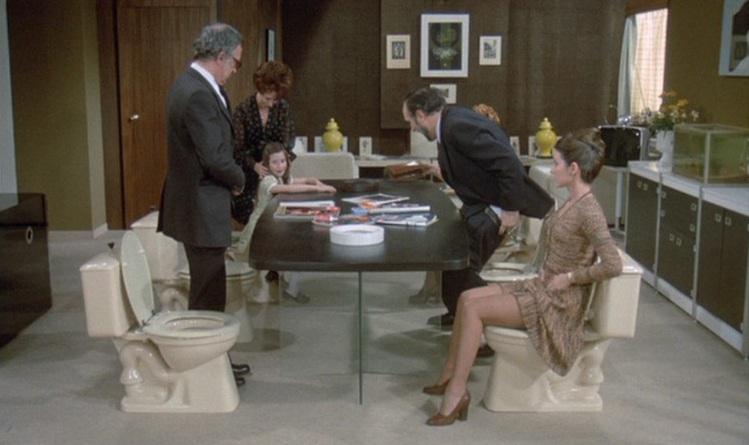This week’s letter comes to you from Yorkshire in the north of England.
While I’ve been up here, I’ve been thinking a lot about weirdness.
I’ve been watching the final films of Luis Buñuel, the Spanish surrealist. His penultimate movie, Le Fantôme de la Liberté (1974), is basically a sequence of unrelated vignettes tied together very incidentally, each more bizarre than the last.
In one scene, two guests arrive at a friend’s Parisian apartment seemingly for a meal. We follow them inside - and find all the chairs replaced with toilets.

A scene from Le Fantôme De La Liberté by Luis Buñuel (1974)
The party proceed to pull their cacks down and do their business together, continuing their conversation as if nothing is out of the ordinary. After a while, one man rises, pulls up his trousers and meekly asks “where is your dining room?”
“Down the corridor on the right” is the reply and we follow the man as he locks himself in a small room to eat by himself.
The whole scenario made me laugh out loud, it’s so unapologetically weird.
Weirdness has been a point of conflict in my creative life. As a young man I desperately wanted not to be weird and this played out in my earliest attempts at telling stories.
As I grew more comfortable with myself, some of my innate weirdness began to creep into my work.
My video essays over the years are all weird in one way or another, not least in their meandering subject matter, earnestly trying to tell stories about things no-one is that interested in. I was making them during a ‘golden age’ of video essays but they always stood apart too much to enjoy that glow.
The weirdest thing I’ve made so far is Parallax, a science fiction documentary-cum-climate change parable, narrated by an English grandmother. It talks about corporations as if they are trees and showed the planet rotating upside-down.
I’m really proud of Parallax and I know a lot of you liked it too - but the internet didn’t know what to do with it.
It defied categorisation. It was published at strange intervals, it didn’t follow any of the accepted wisdom of how to make videos successfully on YouTube; it has been rejected from every competition and festival I submitted it to.
And this is the conflict of weird.
I am busy making a series of films with the computer scientist and author Jaron Lanier. He is deeply worried that we are blindly building a civilisation ruled by algorithms where humans are relegated to second-class citizens.
I’m worried too. Algorithms have many practical uses but at their core they demand logic. Things must be filtered, ordered, categorised, yes, no, if, then…
And think about this: the videos you are recommended on YouTube, the music that gets promoted to you on Spotify, the articles that make it onto your Facebook feed, the shows you see on Netflix, the books you discover on Amazon and the conversations you have on Twitter…so much of our cultural life is now governed by algorithms!
Jaron is mentioned in Jenny Odell’s new book How To Do Nothing: Resisting the Attention Economy, which I have been reading this week. In the introduction she explains how algorithm-created-culture is dangerous:
“…there’s a tendency towards an aggressive monoculture, where those components that are seen as “not useful” and which cannot be appropriated are the first to go.”
The danger is two-fold: firstly, weird art is deemed “not useful” and discarded; secondly, we humans are encouraged and rewarded for making “useful” things the algorithm can read - and we end up with shit that looks the same.
If Luis Buñuel were a YouTuber today would he be able to film a group of people on the toilet and make a movie out of it? Would he even want to?
Here is a response to this, of sorts.
Odell argues we must, as individuals, wrestle control of our attentions back, away from algorithmic distractions, and direct it towards better things. She calls this action Resisting in Place:
“To resist in place is to make oneself into a shape that cannot so easily be appropriated by a capitalise value system…It means recognising and celebrating a form of the self that changes over time, exceeds algorithmic description…”
Exceeds algorithmic description! What a line! That should be on the business card of every artist across the land.
Alongside this line I hastily scribbled the following note in the margin: ‘Make stuff a computer cannot categorise.’
I’m weird. You’re weird.
Go out there and exceed algorithmic description. Make art the computer cannot categorise.
Thanks to those of you who sent in a question for a Q&A this week. I didn’t get enough to justify a full letter - but please keep them coming.
As soon as I have five I’ll answer all of them in a single letter!
Until another Sunday soon,
